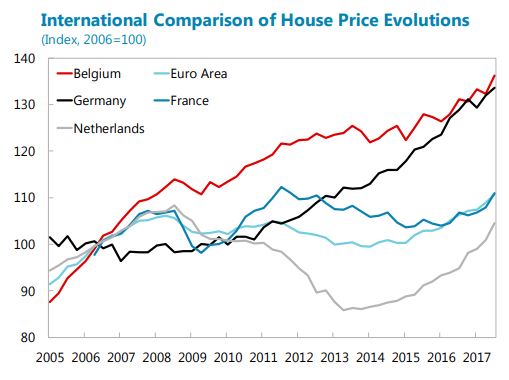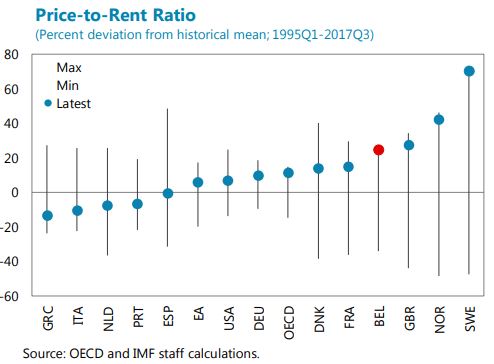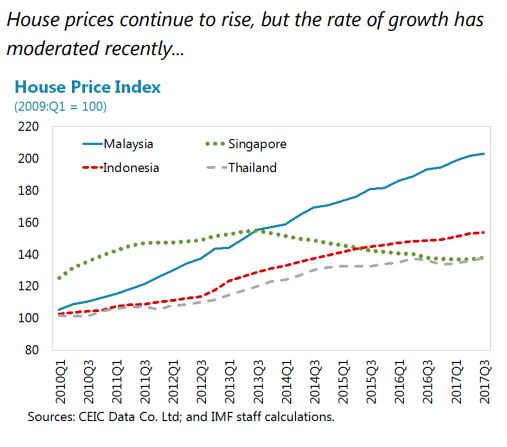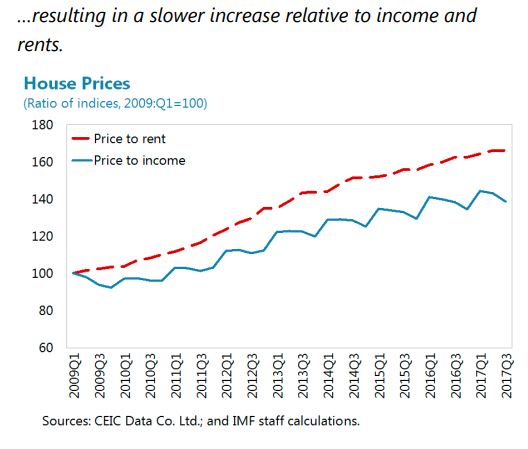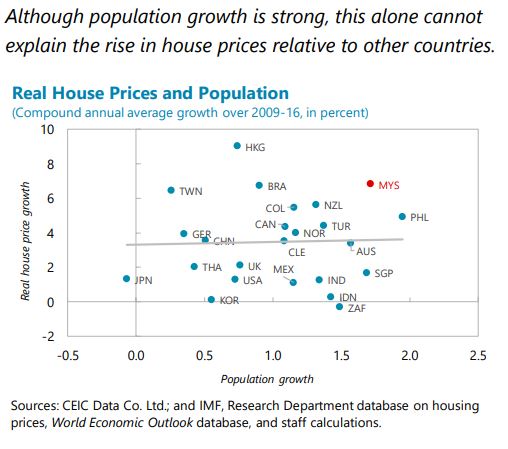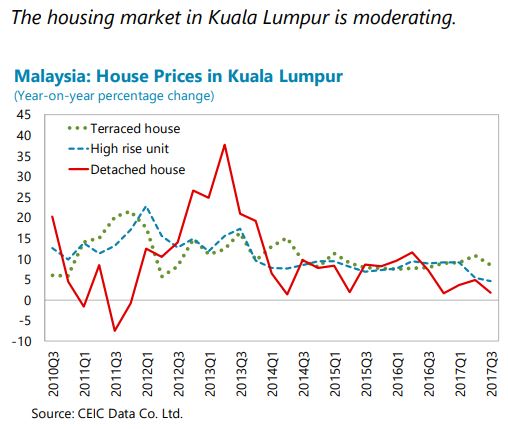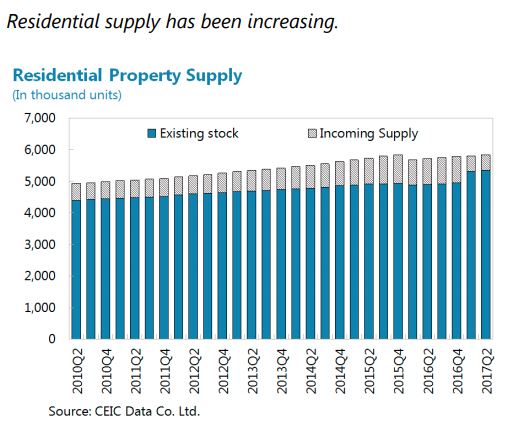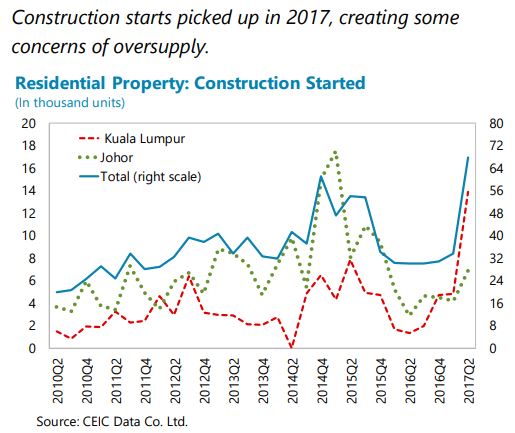Thursday, March 8, 2018
Housing Market in Belgium
The latest IMF report on Belgium says that:
“The housing market appears to be only moderately overvalued, but pockets of vulnerability exist. Having grown rapidly in the 2000s, residential housing prices did not experience a sharp decline during the crisis, and have since risen by about 20 percent in nominal terms. The price-to-rent and price-to-income ratios stand well above their historical averages. More sophisticated measures, however, indicate only a moderate overvaluation. Since 2015 there has been a reversal in the tightening of mortgage lending standards, as evidenced by a growing share of loans with high loan-to-value (LTV) and/or high debt service-to-income (DSI) ratios. Risks are mitigated to some extent by the fact that Belgian households generally hold considerable financial assets. Nevertheless, nearly a third of outstanding mortgage debt is held by households whose liquid financial assets cover less than six months of debt service.
It will be important to stand ready to tighten macroprudential conditions further if balance sheet risks were to grow significantly. To address growing risks in the housing market, the NBB in 2014 introduced a 5 percent risk weight add-on for banks using internal ratings models to determine their minimum regulatory capital requirements for mortgage loans. In 2017, the NBB proposed a tightening of macroprudential policies through a targeted increase in capital charges linked to the riskiness of exposures, proxied by LTV ratios. However, as this proposal was not accepted by the government, the NBB subsequently proposed a new macroprudential measure requiring banks with riskier mortgage portfolios to hold more capital. This measure should be enacted promptly. Looking ahead, it will be important to strengthen the NBB’s ability to deploy cyclical macroprudential measures in the financial sector in a timely manner.”
The latest IMF report on Belgium says that:
“The housing market appears to be only moderately overvalued, but pockets of vulnerability exist. Having grown rapidly in the 2000s, residential housing prices did not experience a sharp decline during the crisis, and have since risen by about 20 percent in nominal terms. The price-to-rent and price-to-income ratios stand well above their historical averages. More sophisticated measures, however, indicate only a moderate overvaluation.
Posted by at 4:26 PM
Labels: Global Housing Watch
Housing Market in Malaysia
The IMF’s latest report on Malaysia says that:
“Measures could be considered to mitigate risks to financial stability. For the housing (…) market, possible measures could include risk weights and lending limits targeting the construction sector, and measures encouraging developers to lease the housing stock that remains unsold for an extended period. To encourage the rental market, the authorities could look into reforming the regulations pertaining to rents and tenant-landlord relationships or granting developers tax exemptions for rental income on leasing units, within the context of the approved government budget envelope. On mortgage lending, sector-wide LTVs (on the second and first properties) and debt service to income limits could supplement the ones that are presently selfimposed by the banks, complementing the existing limit for borrowers with income under 3,000 ringgits per month. Strong economic conditions offer a good window of opportunity for the above policy adjustments.”
The IMF’s latest report on Malaysia says that:
“Measures could be considered to mitigate risks to financial stability. For the housing (…) market, possible measures could include risk weights and lending limits targeting the construction sector, and measures encouraging developers to lease the housing stock that remains unsold for an extended period. To encourage the rental market, the authorities could look into reforming the regulations pertaining to rents and tenant-landlord relationships or granting developers tax exemptions for rental income on leasing units,
Posted by at 4:20 PM
Labels: Global Housing Watch
Housing View – March 9, 2018
On cross-country:
- Global House Price Index – Q4 2017 – Knight Frank
- 2018 Emerging Models in Real Estate Report – Mike DelPrete
On the US:
- The Effects of Rent Control Expansion on Tenants, Landlords, and Inequality: Evidence from San Francisco – NBER
- Shocker! Rent Control Makes Housing Scarcer and More Expensive – Reason
- Eliminating Fannie Mae and Freddie Mac without legislation – American Enterprise Institute
- Income Doesn’t Determine Whether People Buy Homes, for Now – Zillow
- De Blasio Bolsters Affordable Housing, but at What Price? – New York Times
- NYC perseveres with affordable housing agenda despite costly obstacles – Curbed
- Home sales falling in the U.S. – but not for the reason you think – Global Property Guide
- The Rise and Fall of American Public Housing – Citylab
- In California, Momentum Builds for Radical Action on Housing – Citylab
- State and Local Health and Housing Integration Projects – Center on Budget and Policy Priorities
- The mortgage market risk no one’s talking about, plus a proposal to redesign the system – Brookings
On other countries:
- [Germany] Landlords Shed No Tears Over Broken German Housing Market – Wall Street Journal
- [Nambia] House Prices in Namibia – IMF
- [New Zealand] Funding cost pass-through to mortgage rates – Reserve Bank of New Zealand
- [New Zealand] New Zealand to hit property speculators with taxes on capital gains – Global Property Guide
- [Switzerland] That Zurich Lakeside Property May Finally Become More Affordable – Bloomberg
- [United Kingdom] The housing market in the macroeconomy – National Institute of Economic and Social Research
- [United Kingdom] Detailed household expenditure for mortgage-paying households, by gross income quintile group, UK, financial year ending 2015 to financial year ending 2017 – Office for National Statistics
Photo by Aliis Sinisalu
On cross-country:
- Global House Price Index – Q4 2017 – Knight Frank
- 2018 Emerging Models in Real Estate Report – Mike DelPrete
On the US:
- The Effects of Rent Control Expansion on Tenants, Landlords, and Inequality: Evidence from San Francisco – NBER
- Shocker! Rent Control Makes Housing Scarcer and More Expensive – Reason
- Eliminating Fannie Mae and Freddie Mac without legislation – American Enterprise Institute
- Income Doesn’t Determine Whether People Buy Homes,
Posted by at 2:15 PM
Labels: Global Housing Watch
Wednesday, March 7, 2018
Gender Inequality in Nigeria: Macroeconomic Costs and Future Opportunities
The latest IMF country report finds that “Gender inequality in Nigeria is high and widespread across areas of economic opportunities (enforcement of legal rights; access to education, health, financial services) and outcomes (labor force participation, entrepreneurship, political representation, income). These inequalities have led to substantial macroeconomic losses in terms of growth, income equality, and economic diversification. Nigeria’s real GDP per capita growth could, on average, be higher by 1¼ percentage points annually if gender inequality was reduced to that of peers in the region. Addressing challenges in health and education, such as by providing necessary infrastructure (sanitation facilities and electricity), equalizing legal rights, and combatting violence against women and girls, will be essential for Nigeria to reap the demographic dividend from its young and rapidly growing population.”
The latest IMF country report finds that “Gender inequality in Nigeria is high and widespread across areas of economic opportunities (enforcement of legal rights; access to education, health, financial services) and outcomes (labor force participation, entrepreneurship, political representation, income). These inequalities have led to substantial macroeconomic losses in terms of growth, income equality, and economic diversification. Nigeria’s real GDP per capita growth could, on average, be higher by 1¼ percentage points annually if gender inequality was reduced to that of peers in the region.
Posted by at 11:25 AM
Labels: Inclusive Growth
Distributional Impact of Fiscal Reforms in Nigeria
The latest IMF country report on Nigeria finds that “Income inequality and poverty rates are high in Nigeria, with the latter having declined more slowly compared to other countries. At the same time, moving closer to achieving the sustainable development goals and addressing Nigeria’s large development needs will require additional financing. This chapter finds that reforms to generate fiscal space—increases in value-added tax collection, excises, and electricity tariffs—are progressive, i.e. they reduce income inequality. However, they increase poverty gaps and rates to varying extents. Scaling up social safety net transfers and expanding their scope to cover a wider share of the poor can, to some extent, compensate for these adverse impacts at relatively low cost, and bring down poverty rates more generally. In the short term, other measures to shield vulnerable households’ income, including through lifeline electricity tariffs, and higher spending on health and education are needed.”
The latest IMF country report on Nigeria finds that “Income inequality and poverty rates are high in Nigeria, with the latter having declined more slowly compared to other countries. At the same time, moving closer to achieving the sustainable development goals and addressing Nigeria’s large development needs will require additional financing. This chapter finds that reforms to generate fiscal space—increases in value-added tax collection, excises, and electricity tariffs—are progressive, i.e. they reduce income inequality.
Posted by at 11:20 AM
Labels: Inclusive Growth
Subscribe to: Posts




